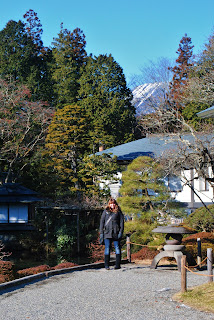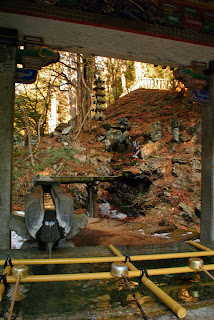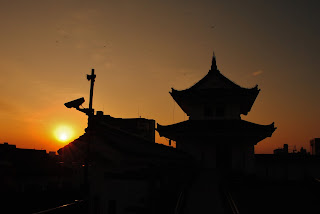And so it was on a clear morning in January that we set out for our last great adventure before Nikki had to go home. Our destination: Nikko. Our means: the open road and Kei, my car. It took a few hours, because I'm too cheap for the expressway, but in the end we had a really peaceful drive through the mountains and then first up to Lake Chuzenji. I had been to Nikko once before, with Rhee, on the way back from a seishun 18 trip to Sendai but it was brief so we had missed a few of the sights including the mountain resort above the town. So first on my new itinerary was the lake. I had to drive up the windy road that climbed the mountain in such steep curves that the road was only one way going up and numbers were assigned to each switchback (42 in all I think?). But eventually we made it to the top and were rewarded by a beautiful, albeit very chilly, afternoon by the lake, with a shrine and a waterfall. We were some of the only people up there braving the cold as we parked at the second of three Futarasan shrines. The main one is in Nikko and the third at the top of one of the mountains. It was snowy and still decorated for the New year's festivals and there was a maiko organizing fortunes and a little monkey up in a tree. Carrying on we took in the 100 meter Kegon Falls from the safety of an observation deck, whose two stories latched on to the side of a cliff. Even in the brown of winter it was rather magnificent as it poured down into a cone of snow. And then, as the sun fell behind the mountains, we journeyed back down the other side of the curvy road and ended up in Nikko, but it was late so we went straight for our hotel instead.
That was rather an adventure in itself because it was the off season, meaning that we and a young gaijin couple were the only guests in our hotel that was a little eerie with emptiness. We went for a long walk in search of food, crossing the gorge out hotel backed onto, and found nothing, so we walked back, found the station and eventually a ramen shop. The owner was very pleasant and impressed by my terrible Japanese so that was fun. We went back, had a bath, and went to bed.
Nikko was of course amazing. Despite Tami saying it would suck in winter, it was as fantastic as it was in summer. It's surrounded by evergreens which easily made me forget the season (well the cold didn't) and we got their early enough to beat the constant crowds. Unlike last time when Rhee and I wandered about without direction we followed the suggested guide. First we went to this garden as part of the main temple and wandered around the lonely expanse of moss and hibernating flowers (there were no koi to feed this time ;_;) then we went to the Tokugawa treasure house and last, in this complex; we went to Rinnoji. Rinnoji is apparently 'Nikko's most important temple,' but it's under construction until 2021! I can't even imagine that year but maybe one day I'll be reading this in 2021 and chuckle because it wasn't that far away after all... Anyways, we were allowed to walk around inside the scaffolding and see some rarely viewed treasures but that wasn't really why we came to Nikko.
So next we went to the best part! The Tokugawa mausoleum: Toshogu shrine! Seriously maybe the most beautiful and elaborately decorated shrine I've ever been to. It helps that Nikki and I are both big fans of the great samurai leader Tokugawa Ieyasu (the third unifier of Japan) and this mausoleum is his final resting place as designed by his grandson Iemitsu. (Who also has a mausoleum in Nikko and I'm left wondering why he felt his father didn't quite make the cut lol.) Anyway, we walked along a tree lined path--all good things in Japan begin with a lane cloaked in tree shadows--passed the famous five story pagoda and crossed through under the first of three beautiful gates. The shrine opened before us, angling to the right past the place with the three moneys--see no evil, hear no evil, speak no evil--and the first of the shrine shops were I bought a shrine for protection, under a torii gate surrounded by ancient lanterns with more moss than stone visible and up the stairs to the most famous attraction: the Yomeimon gate. If I went into details explaining ever intricate design, carving and painting I would be at this for hours and never capture the awe. Toshogu is so awesome. There was a peaceful hush, even when the tourists woke up and began pouring in, and the sky was clear, the trees blocked out the wind and I felt transported to another land. Climbing up to the third level was the simplest structure but also that grave of Ieyasu. There was also this sleeping cat that's supposed to represent that not even a mouse may disturb him or something like that, it's a little lost on me. Finally, on the second level again, we went into the main shrine, dim despite the bright sun and I kneeled before the main altar, on the tatami mats gold with age and closed my eyes never wanting to leave as I prayed. The last building was the dragon hall where a monk showed us the affect of the acoustics by banging together a pair of wooden sticks and seeing how the sound resonated differently in different parts of a room surrounded in statues and painted with an amazing dragon on the ceiling. He then roped me into their marketing by making me fall in love with this little bell they sold that made the most beautiful sound I have ever heard a bell make. I spent another half hour just wandering about, letting my fingers graze the old stone and soft moss, and wishing I never had to leave and found myself near tears to leave the place when at last it was time to move on.
Another tree lined path lead to adjacent complex to the main Futarasan shrine which was really one big shrine and with a little village of different little shrines, a haunted lantern, a little waterfall fountain and a beautiful atmosphere as if the shrine was built from the nature surrounding it.
I suppose the last major sight to visit was Iemitsu's mausoleum, Taiyuinbyo. It was much more subdued to his grandfather's counterpart in that where Ieyasu had bright colours. Iemitsu went with blacks and reds and a deeper gold. There were also less people visiting him which may have explained the stifling silence. The gate was under construction but the main building was beautiful and had many dragon designs I really loved. His grave is actually inaccessible but it's through a very alluring gate leading to a set of stairs so enchanting I considered trespassing; but pretty sure that would have earned me a fast track ticket out of Japan lol. As it happened, my favourite things about his shrine was this little meadow of lanterns we couldn't reach but was visible from up the stairs, and the main fountain which channels it's water from a waterfall, down a little wooden path and to the dragon for purifying. it was really neat!
We were both thoroughly pleased with ourselves and Nikko as we treked out of the historic wonderland to the famous red bridge once used as the only way to cross over into the precinct. I've mentioned the three unique bridges before and this is considered one of them but so is this really awesome one made out of vines in Shikoku and I'm more inclined to say that's unique over a simple red bridge. Not to take away from red bridges because I love red shrine bridges! Anyways, it costs a bunch of money to cross it so we just admired it from afar and then went into town to do some shopping. Nikki bought me an adorable Hello Kitty Ieyasu phone strap for my map! Thank you!
Then we got in the car and headed out. It was still only afternoon so we wondered what else to do. In the end I remembered that Utsunomiya was famous for gyoza and we headed there! On the way we drove beside (and a few times through) the full extent of the tree lined path that had led to Ieyasu's shrine. I hadn't realized the full length of if until I learned that the path is mostly intact from the Edo era when great processions of the shogun and those who worshipped Tokugawa would travel up from Edo on pilgrimages. It made for a very nice drive. But moving away from the rural areas near the mountains we found ourselves back in the city, the city being Utsunomiya; capital of gyoza. I took Nikki up to this little shop Rhee and I found ages ago, up a narrow staircase to a restaurant smaller than my apartment. There we feasted on fried gyoza, breaded gyoza and roasted gyoza! It was fabulous! We grabbed coffee at Tully's and as the sun set we stopped at the remains of Utsunomiya Castle, famous for one of the last battles of the Shinsengumi and Hijikata Toshizou! Wasn't much to look at but I liked that I was in the same place as the Shinsengumi and as the sky turned gold and red I felt it was the perfect ending to a perfect weekend.
I intended to write about the Ghibli Museum and Tokyo in this post but realize it's quite long enough so I'll leave it to next post! Apparently we did way too much!








































No comments:
Post a Comment